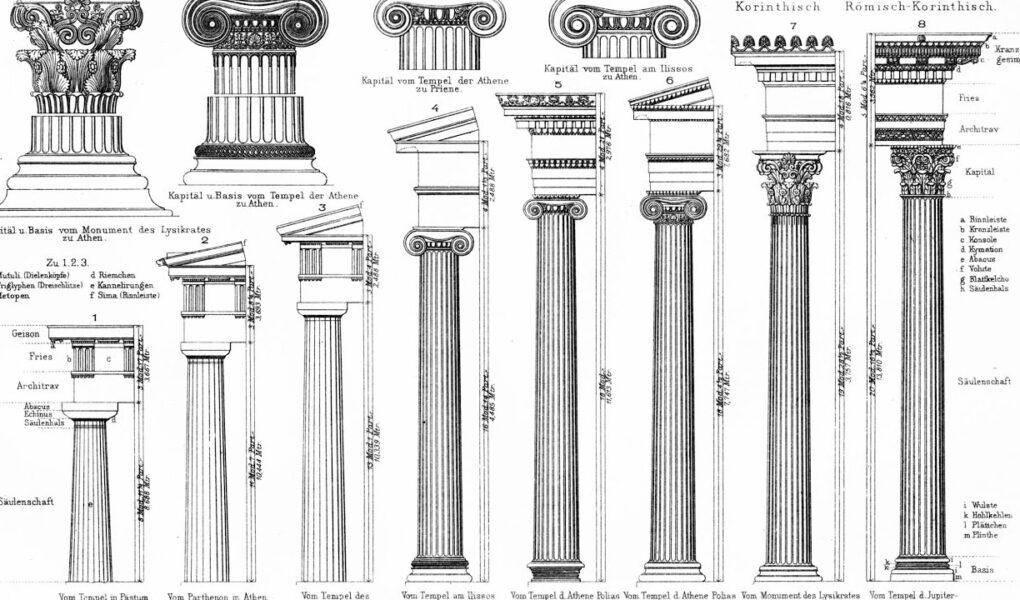Smarthistory
A conversation with Dr. Steven Zucker & Dr. Beth Harris
In classical architecture, the Orders consist of variations of an assembly of parts made up of a column (usually with a base), a capital, and an entablature. These structural units may be repeated and combined to form the elevation of a building and its architectural vocabulary.
There are eight Orders in total: Doric (Greek and Roman versions), Tuscan, Ionic (Greek and Roman), Corinthian (Greek and Roman), and Composite. The simplest is the Tuscan, supposedly derived from the Etruscan-type temple. It has a base and capital and a plain column. The Doric is probably earlier, however, its Greek version having no base, as on the Parthenon. The Ionic Order, with its twin volute capitals, originated in Asia Minor in the mid-6th century B.C.E. The Corinthian Order was an Athenian invention of the 5th century B.C.E. and was later developed by the Romans. The Composite Order is a late Roman combination of elements from the Ionic and Corinthian Orders.
The Concise Oxford Dictionary of Art Terms, Michael Clarke, Deborah Clarke. © 2012 Oxford University Press. Available at Oxford Art OnlineAncient Greece
. Created by Beth Harris and Steven Zucker.
Source




Does anyone know where the naming conventions come from?
Thank you! Your dialog is amazing way to present information 🙂
man, even after 10 years you guys are JUST AMAZING. WE LOVE YOU!!!!!!
A student who's memorising history of arts passed by here🙋🏻♀️
Great job! You two….. amazing
Did the Ionic Order come after the Doric though? Sometimes the Doric order is considered the earliest order, but there is no evidence to support this. Rather, the Doric and Ionic orders seem to have appeared at around the same time. Originally built from wood, the Ionic originated in eastern Greece and the Doric in the west and mainland".
modern architecture uses columns a lot! especially on facades of homes.
THANK YOU SO MUCH. I LOVE LEARNING ABOUT GREEK AND ROMAN ARCHITECTURE. SO MUCH FUN!!!!
THE CORINTHIAN REMINDS ME OF EGYPT. WHICH WAS A GROWING CULTURE AS WELL.
amazing and beautiful
Excellent presentation. Simple and understandable. I wish all the people who decorate their houses with these orders (but do it without knowing how) would watch this.
Is there anything behind the little flower at the top of the Roman-Corinthian capital?
I don't believe the ancient Greeks created this architecture because it's a all over the world from Japan to Peru. History isn't correct.
Nice
Dia 21/04/2023 voltando para terminar ''Uma introdução a história da arte'' no Khan Academy.
xD
Ancient Egyptian column designs predates classical Greek and Roman designs by at least 2000 years!
They have made me fall in love with the long question of my arts book which I hate and don't want to study 😅
this was so cool. A+
very usful
I have a test tomorrow on this topic and this video really helped thank you so much for making this!
"Guys, you're gonna love this, it's a cute, funny little story… So a young girl dies, right?"
Everyone: 😐😅
lol. I just wasn't expecting that – it made for an awkward chuckle. But this was interesting to learn about! I want to make another awkward joke about "learning that I'm built like a Doric temple, but '~ gradually getting my ionic on~.'" I'm sure the reaction would be similar.
Really a nice rundown. Probably the best video I've seen of you guys' to date! Keep it up! 🙂
Lincoln Logs as Child, OG Lego's
here 30 mins before a test😂🥲
Great information and explanations of the Architectural feaures
The Greeks got these ideas from Egypt, where the Karnak temple's columns and general sructure are even much older. The Greek version is already their own interpretation of much older ideas.
спасибо за разбор из России
I love that this content exists, thank you.
Great video! Does anybody know what the function of the scamillus is? (Unfortunately it wasn’t mentioned in the video, but it is the intention under the hypotrachelion)
Fascinating and well explained.
And now i see modern architects using the columns like a straight smooth tube, and it looks so DULL.
Nice 👍
Спасибо 🤗, очень красиво и интересно показано🙏🙏🙏. Thank you from Russia 🤗🇷🇺🇷🇺❤️🇷🇺❤️
Entasis is a beautiful nuance yeah
well explained thank you Dr. Steven and Beth.
Ihren kunstwissenschaftlichen Stil finde ich genial, durch Gespräche und Diskussionen Erkenntnis zu gewinnen. Unglaublich bereichernd und hilfreich beim Lernen zu sehen. Herzlichsten Dank und Gruß. 🙏
There is a full-size 1:1 replica of the Parthenon in Nashville, TN including the statue of Athena inside.
Thanks for this.
There’s also Aeolic, like crazy Ionic
Oldest "Composite" Column is from Ai Khanoum….or as the Greeks called it Alexandreia Eschate! It was Greek too!!!
bravo bravo 👏
Their temples look like our government buildings.
Until I saw this, my knowledge of Greek orders involved souvlaki, gyros and moussaka
Geometria e percepção e experiência humana
I have a history exam tomorrow and I’m here to say this. Architecture sucks and that’s what makes it fun. Cuz when it’s rewarding damn is it rewarding… I’ll let you guys know how my exam goes <3 ty for the video
WH? , because it beautiful! That's why! 7:07 I wish I would have been involved in this sort of work. The University didn't accept a dumby like me. Keep up the good work, I love this
Ancient Greek architectial systems inspired from Eygptian architectial systems
Doric order was inspired from Eygptians,Ionic order inspired from Hittit order.That is,These architectial systems are synthesis of ancient civilizations.
♥